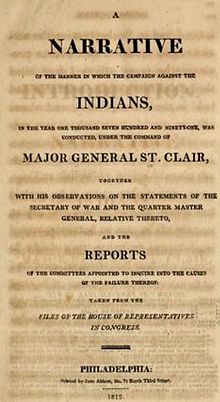
Arthur St. Clair

Arthur St. Clair | |
|---|---|
 Portrait by Charles Willson Peale, c. 1783 | |
| 1st Governor of the Northwest Territory | |
| In office July 15, 1788 – November 22, 1802 | |
| Preceded by | Position established |
| Succeeded by | Charles Willing Byrd |
| 4th Senior Officer of the United States Army | |
| In office March 4, 1791 – March 5, 1792 | |
| President | George Washington |
| Preceded by | Josiah Harmar |
| Succeeded by | Anthony Wayne |
| 7th President of the Confederation Congress | |
| In office February 2, 1787 – November 4, 1787 | |
| Preceded by | Nathaniel Gorham |
| Succeeded by | Cyrus Griffin |
| Personal details | |
| Born | March 23, 1737 Thurso, Caithness |
| Died | August 31, 1818 (aged 81) Greensburg, Pennsylvania |
| Resting place | St. Clair Park, Greensburg |
| Political party | Federalist |
| Alma mater | University of Edinburgh |
| Signature | |
| Military service | |
| Allegiance |
|
| Branch/service |
|
| Rank |
|
| Battles/wars | |
Major-General Arthur St. Clair (March 23, 1737[1] [O.S. 1736] – August 31, 1818) was a Scottish-born American military officer and politician. Born in Thurso, Caithness, he served in the British Army during the French and Indian War before settling in the Province of Pennsylvania. During the American Revolutionary War, he rose to the rank of major general in the Continental Army, but lost his command after a controversial retreat from Fort Ticonderoga.

After the war, he served as President of the Continental Congress, which during his term passed the Northwest Ordinance. He was then made governor of the Northwest Territory in 1788, and then the portion that would become Ohio in 1800. In 1791, St. Clair commanded an American army in St. Clair's defeat, which was one of the worst defeats suffered by the United States military at the hands of Native Americans. Politically out-of-step with the Jefferson administration, he was replaced as governor in 1802.

Early life and career
St. Clair was born in Thurso, Caithness. Little is known of his early life. Early biographers estimated his year of birth as 1734,[2] but subsequent historians uncovered a birth date of March 23, 1736, which in the modern calendar system means that he was born in 1737. His parents, unknown to early biographers, were probably William Sinclair, a merchant, and Elizabeth Balfour.[1] He reportedly attended the University of Edinburgh before being apprenticed to the renowned physician William Hunter.[1]

In 1757, St. Clair purchased a commission in the British Army's Royal American Regiment, and came to America with Admiral Edward Boscawen's fleet for the French and Indian War. He served under General Jeffery Amherst at the capture of Louisburg, Nova Scotia, on July 26, 1758. On April 17, 1759, he received a lieutenant's commission and was assigned under the command of General James Wolfe, under whom he served at the Battle of the Plains of Abraham which resulted in the capture of Quebec City.

Settler in America
On April 16, 1762, he resigned his commission, and, in 1764, he settled in Ligonier Valley, Pennsylvania, where he purchased land and erected mills. He was the largest landowner in Western Pennsylvania.

In 1770, St. Clair became a justice of the court, of quarter sessions and of common pleas, a member of the proprietary council, a justice, recorder, and clerk of the orphans' court, and prothonotary of Bedford and Westmoreland counties.

In 1774, during Lord Dunmore's War, the colony of Virginia took claim of the area around Pittsburgh, Pennsylvania, and some residents of Western Pennsylvania took up arms to eject them. St. Clair issued an order for the arrest of the officer leading the Virginia troops. The boundary dispute between Virginia and Pennsylvania wasn't settled until 1780 when both sides agreed to extend the Mason-Dixon line westward from Maryland to 80° 31′ west, the current western border of Pennsylvania (see: District of West Augusta)

Revolutionary War
By the mid-1770s, St. Clair considered himself more of an American than a British subject. In January 1776, he accepted a commission in the Continental Army as a colonel of the 3rd Pennsylvania Regiment. He first saw service in the later days of the Quebec invasion, where he saw action in the Battle of Trois-Rivières. He was appointed a brigadier general in August 1776, and was sent by Gen. George Washington to help organize the New Jersey militia. He took part in George Washington's crossing of the Delaware River on the night of December 25–26, 1776, before the Battle of Trenton on the morning of December 26. Many biographers credit St. Clair with the strategy that led to Washington's capture of Princeton, New Jersey, on January 3, 1777.[3] St. Clair was promoted to major general in February 1777.

In April 1777, St. Clair was sent to defend Fort Ticonderoga. His outnumbered garrison could not resist British General John Burgoyne's larger force in the Saratoga campaign. St. Clair was forced to retreat at the Siege of Fort Ticonderoga on July 5, 1777. He withdrew his forces and played no further part in the campaign. In 1778 he was court-martialed for the loss of Ticonderoga.[4] The court exonerated him and he returned to duty,[4] although he was no longer given any battlefield commands. He still saw action, however, as an aide-de-camp to General Washington, who retained a high opinion of him. St. Clair was at Yorktown when Lord Cornwallis surrendered his army. During his military service, St. Clair was elected a member of the American Philosophical Society in 1780.[5]

President of the United States in Congress Assembled
St. Clair was a member of the Pennsylvania Council of Censors in 1783 and was elected a delegate to the Confederation Congress, serving from November 2, 1785, until November 28, 1787. Chaos ruled the day in early 1787 with Shays's Rebellion in full force and the states refusing to settle land disputes or contribute to the now six-year-old federal government. On February 2, 1787, the delegates finally gathered into a quorum and elected St. Clair to a one-year term as President of the Continental Congress. Congress enacted its most important piece of legislation, the Northwest Ordinance, during St. Clair's tenure as president. Time was running out for the Confederation Congress, however; during St. Clair's presidency, the Philadelphia Convention was drafting a new United States Constitution, which would abolish the old Congress.

Northwest Territory

Under the Northwest Ordinance of 1787, which created the Northwest Territory, General St. Clair was appointed governor of what is now Ohio, Indiana, Illinois, Michigan, Wisconsin and part of Minnesota. He named Cincinnati, Ohio, after the Society of the Cincinnati,[6] and it was there that he established his home.

As Governor, he formulated Maxwell's Code (named after its printer, William Maxwell), the first written laws of the territory. He also sought to end Native American claims to Ohio land and clear the way for white settlement. In 1789, he succeeded in getting certain Native Americans to sign the Treaty of Fort Harmar, but many native leaders had not been invited to participate in the negotiations, or had refused to do so. Rather than settling the Native Americans' claims, the treaty provoked them to further resistance in what is also sometimes known as the "Northwest Indian War" (or "Little Turtle's War"). Mutual hostilities led to a campaign by General Josiah Harmar, whose 1,500 militiamen were defeated by the Native Americans in October 1790.

Army commander 1791
In March 1791, St. Clair succeeded Harmar as commander of the United States Army and was commissioned as a major general. He personally led a involving two Regular Army regiments and some militia. In October 1791 as an advance post for his campaign, Fort Jefferson (Ohio) was built under the direction of General Arthur St. Clair. Located in present-day Darke County in far western Ohio, the fort was built of wood and intended primarily as a supply depot; accordingly, it was originally named Fort Deposit.

St. Clair's defeat
In November 1791, near modern-day Fort Recovery, his force advanced to the location of Native American settlements near the headwaters of the Wabash River. On November 4 they were routed in battle by a tribal confederation led by Miami Chief Little Turtle and Shawnee chief Blue Jacket. The tribes were aided by British agents Alexander McKee and Simon Girty. More than 600 American soldiers and scores of camp followers were killed in the battle, which has since borne the name "St. Clair's Defeat", also known as the "Battle of the Wabash", the "Columbia Massacre," or the "Battle of a Thousand Slain". It remains the greatest defeat of a U.S. army by Native Americans in history, with about 623 American soldiers killed in action and about 50 Native Americans killed. The wounded were many, including St. Clair and Capt. Robert Benham.[7][8][9]

Continued as Governor 1788-1802
Although an investigation exonerated him, St. Clair resigned his army commission in March 1792 at the request of President Washington. He continued to serve as Governor of the Northwest Territory.


A Federalist, St. Clair hoped to see two states made of the Ohio Territory in order to increase Federalist power in Congress. However, he was opposed by Ohio Democratic-Republicans for what were perceived as his partisanship, high-handedness, and arrogance in office. In 1802, St. Clair remarked the U.S. Congress had no power to interfere in the affairs of those in the Ohio Territory. He also stated the people of the territory "are no more bound by an act of Congress than we would be bound by an edict of the first consul of France." This led President Thomas Jefferson to remove him from office as territorial governor.[10] He thus played no part in the organizing of the state of Ohio in 1803.

The first Ohio Constitution provided for a weak governor and a strong legislature, in part as a reaction to St. Clair's method of governance.

Family life
St. Clair met Phoebe Bayard, a member of one of the most prominent families in Boston, and they were married in 1760. Miss Bayard's mother's maiden name was Bowdoin and she was the sister of James Bowdoin, colonial governor of Massachusetts. His eldest daughter was Louisa St. Clair Robb, a mounted messenger and scout, and known as a beautiful huntress.

Like many of his Revolutionary era peers, St. Clair suffered from gout as noted in correspondence with John Adams.[11]

Death
In retirement St. Clair lived with his daughter, Louisa St. Clair Robb, and her family on the ridge between Ligonier and Greensburg.

Arthur St. Clair died in poverty in Greensburg, Pennsylvania, on August 31, 1818, at the age of 81. His remains are buried under a Masonic monument in St. Clair Park in downtown Greensburg.[12] St. Clair had been a petitioner for a Charter for Nova Caesarea Lodge #10 in Cincinnati, Ohio, in 1791.[13] This Lodge exists today, as Nova Caesarea Harmony #2.[14] His wife Phoebe died shortly after and is buried beside him.

Legacy
A portion of the Hermitage, St. Clair's home in Oak Grove, Pennsylvania (north of Ligonier), was later moved to Ligonier, Pennsylvania, where it is now preserved, along with St. Clair artifacts and memorabilia at the Fort Ligonier Museum.

An American Civil War steamer was named USS St. Clair.

Lydia Sigourney included a poem in his honor, ![]() General St. Clair. in her first poetry collection of 1815.
General St. Clair. in her first poetry collection of 1815.

The site of Clair's inauguration as Governor of the Northwest Territory is now occupied by the National Start Westward Memorial of The United States, commemorating the settlement of the territory.[15]

Places named in honor of Arthur St. Clair include:

In Pennsylvania:

- Upper St. Clair, Pennsylvania
- St. Clairsville, Pennsylvania
- St. Clair Schuylkill County, Pennsylvania
- St. Clair Township, Westmoreland County, Pennsylvania
- East St. Clair Township, Bedford County, Pennsylvania
- West St. Clair Township, Bedford County, Pennsylvania
- The St. Clair neighborhood in Pittsburgh, Pennsylvania
- St. Clair Hospital, Mt. Lebanon, Pennsylvania
In Ohio:

- St. Clair Township in Butler County, Ohio
- St. Clair Township in Columbiana County, Ohio,
- St. Clairsville, Ohio
- St. Clair Avenue in Cleveland, Ohio
- St. Clair Street in Dayton, Ohio
- St. Clair Street in Toledo, Ohio
- St. Clair Street in Marietta, Ohio
- Fort St. Clair in Eaton, Ohio
Other States:

- St. Clair County, Illinois
- St. Clair Street in Indianapolis, Indiana
- St. Clair County, Missouri
- St. Clair County, Alabama
- St. Clair Street in Frankfort, Kentucky, was named for the St. Clair by Gen. James Wilkinson, who laid out the town that became the state capital. The street's north end is at the Old Capitol, and near its south end is the Franklin County Court House; both were designed by Gideon Shryock.
In Scotland:

References
Notes

- ^ a b c Gregory Evans Dowd. "St. Clair, Arthur", American National Biography Online, February 2000.
- ^ Smith, St. Clair Papers, 1:2.
- ^ Fischer, David Hackett (2006). Washington's Crossing. Oxford University Press. pp. 313–14. ISBN 0-19-518159-X.
- ^ a b "Major General Arthur St. Clair". National Museum of the United States Army. 27 January 2015.
- ^ "APS Member History". search.amphilsoc.org. Retrieved 6 December 2020.
- ^ Suess, Jeff. "Our history: Who was Cincinnatus, inspiration for city's name?". The Enquirer. Retrieved 5 March 2021.
- ^ Leroy V. Eid, "American Indian Military Leadership: St. Clair's 1791 Defeat." Journal of Military History 57.1 (1993): 71–88.
- ^ William O. Odo, "Destined for Defeat: an Analysis of the St. Clair Expedition of 1791." Northwest Ohio Quarterly (1993) 65#2 pp. 68–93.
- ^ John F. Winkler, Wabash 1791: St Clair's Defeat (Osprey Publishing, 2011)
- ^ Dumas Malone,Jefferson The President: First Term, 1801–1805, Boston: Little, Brown and Company, 1970, pp. 243–44.
- ^ "From John Adams to Arthur St. Clair, 30 May 1797". Founders Online. 30 May 1797. Retrieved 10 March 2022.
- ^ "Buried in Greensburg, Arthur St. Clair a forgotten Revolutionary". Pittsburgh Post-Gazette.
- ^ Brunton, Grover W. (15 November 2007). "General Arthur St. Clair, Soldier, Surveyor, Territorial Governor, and Freemason" (PDF). Archived (PDF) from the original on 9 October 2022. Retrieved 5 November 2019. This article was extracted from an article found on the internet www.heritagepursuit.com/Hamilton/HamiltonChap.I.htm entitled History of Cincinnati and Hamilton County, Ohio
- ^ "About Our Lodge – Nova Caesarea Harmony #2".
- ^ "Memorial to the Start Westward". Ohio Outdoor Sculpture. Retrieved 12 November 2022.
Books

- Kopper, Kevin Patrick. "Arthur St. Clair and the Struggle For Power in the Old Northwest, 1763–1803" (Dissertation. Kent State University, 2005) online Archived 2018-10-04 at the Wayback Machine
- Smith, William Henry, ed. (1882). The Life and Public Services of Arthur St. Clair. Vol. 1. Robert Clarke & Company. ISBN 978-0-598-28691-8.
- Smith, William Henry, ed. (1882). The Life and Public Services of Arthur St. Clair. Vol. 2. Robert Clarke & Company. ISBN 9780598286918.
External links
- 1737 births
- 1818 deaths
- Adjutants general of the United States Army
- Continental Army generals
- Continental Army officers from Pennsylvania
- Continental Army personnel who were court-martialed
- Continental Congressmen from Pennsylvania
- 18th-century American politicians
- 19th-century American politicians
- Governors of Northwest Territory
- Politicians from Cincinnati
- People from Westmoreland County, Pennsylvania
- American people of the Northwest Indian War
- Alumni of the University of Edinburgh
- British military personnel of the French and Indian War
- People from Thurso
- Royal American Regiment officers
- British emigrants to the Thirteen Colonies
- Commanding Generals of the United States Army
See what we do next...
OR
By submitting your email or phone number, you're giving mschf permission to send you email and/or recurring marketing texts. Data rates may apply. Text stop to cancel, help for help.
Success: You're subscribed now !


